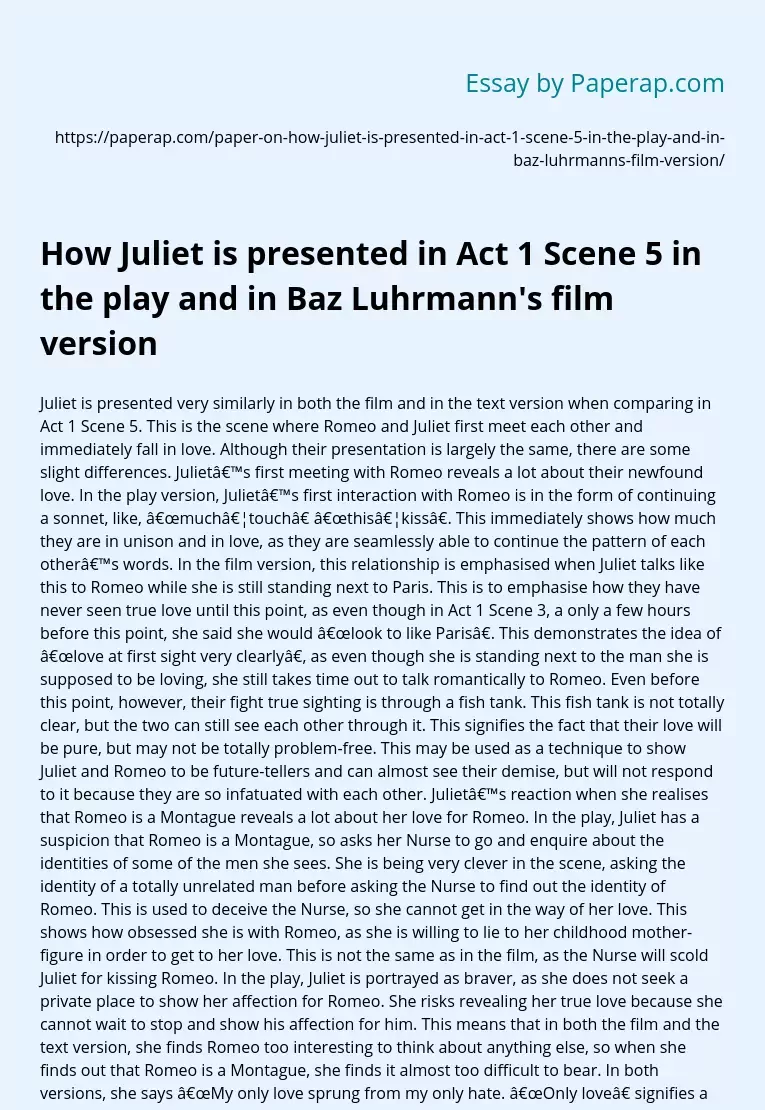Juliet in Act 1 Scene 5 - Play vs Film
Juliet is presented very similarly in both the film and in the text version when comparing in Act 1 Scene 5. This is the scene where Romeo and Juliet first meet each other and immediately fall in love. Although their presentation is largely the same, there are some slight differences. Juliet’s first meeting with Romeo reveals a lot about their newfound love. In the play version, Juliet’s first interaction with Romeo is in the form of continuing a sonnet, like, “much…touch” “this…kiss”.
This immediately shows how much they are in unison and in love, as they are seamlessly able to continue the pattern of each other’s words.
In the film version, this relationship is emphasised when Juliet talks like this to Romeo while she is still standing next to Paris. This is to emphasise how they have never seen true love until this point, as even though in Act 1 Scene 3, a only a few hours before this point, she said she would “look to like Paris”.
This demonstrates the idea of “love at first sight very clearly”, as even though she is standing next to the man she is supposed to be loving, she still takes time out to talk romantically to Romeo.
Even before this point, however, their fight true sighting is through a fish tank. This fish tank is not totally clear, but the two can still see each other through it. This signifies the fact that their love will be pure, but may not be totally problem-free.
This may be used as a technique to show Juliet and Romeo to be future-tellers and can almost see their demise, but will not respond to it because they are so infatuated with each other. Juliet’s reaction when she realises that Romeo is a Montague reveals a lot about her love for Romeo.
In the play, Juliet has a suspicion that Romeo is a Montague, so asks her Nurse to go and enquire about the identities of some of the men she sees. She is being very clever in the scene, asking the identity of a totally unrelated man before asking the Nurse to find out the identity of Romeo. This is used to deceive the Nurse, so she cannot get in the way of her love. This shows how obsessed she is with Romeo, as she is willing to lie to her childhood mother-figure in order to get to her love.
This is not the same as in the film, as the Nurse will scold Juliet for kissing Romeo. In the play, Juliet is portrayed as braver, as she does not seek a private place to show her affection for Romeo. She risks revealing her true love because she cannot wait to stop and show his affection for him. This means that in both the film and the text version, she finds Romeo too interesting to think about anything else, so when she finds out that Romeo is a Montague, she finds it almost too difficult to bear. In both versions, she says “My only love sprung from my only hate.
“Only love” signifies a very true sense of love, so in both versions, she is seen to be a character who either very easily falls in love, or finds true love in the play. Contextual changes have been made to the character of Juliet in the film compared to the play. In the play, love was often a very rushed, not thought about matter, and some couples did not even meet each other until their marriage day. This corresponds to the play, because as soon as they meet each other, they agree to kiss. However, in the modern day, love tends to be more thought about, and couples spend some time properly knowing each other before they marry.
This corresponds to the film, as Romeo and Juliet meet one another through a fish tank before asking to kiss. This represents the considered approach to love today, so can be described as accurate to today’s world. Overall, Juliet is portrayed as a very similar character in both the film version and the play version, and there are only slight differences, like making her love public and also not deceiving her Nurse. To conclude, the play and the film are very similar in their views of Juliet, but the film, being visual, provides us with more clues about her true character.
Juliet in Act 1 Scene 5 - Play vs Film. (2017, Oct 23). Retrieved from https://paperap.com/paper-on-how-juliet-is-presented-in-act-1-scene-5-in-the-play-and-in-baz-luhrmanns-film-version/

